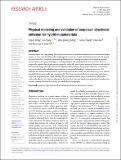| dc.contributor.author | Dong, Erqian | |
| dc.contributor.author | Zhang, Yu | |
| dc.contributor.author | Song, Zhongchang | |
| dc.contributor.author | Zhang, Tianye | |
| dc.contributor.author | Cai, Chen | |
| dc.contributor.author | Fang, Nicholas X | |
| dc.date.accessioned | 2020-09-10T14:12:33Z | |
| dc.date.available | 2020-09-10T14:12:33Z | |
| dc.date.issued | 2019-07 | |
| dc.date.submitted | 2019-06 | |
| dc.identifier.issn | 2053-714X | |
| dc.identifier.uri | https://hdl.handle.net/1721.1/127227 | |
| dc.description.abstract | In wave physics and engineering, directional emission sets a fundamental limitation on conventional simple sources as their sizes should be sufficiently larger than their wavelength. Artificial metamaterial and animal biosonar both show potential in overcoming this limitation. Existing metamaterials arranged in periodic microstructures face great challenges in realizing complex and multiphase biosonar structures. Here, we proposed a physical directional emission model to bridge the gap between porpoises' biosonar and artificial metamaterial. Inspired by the anatomical and physical properties of the porpoise's biosonar transmission system, we fabricated a hybrid metamaterial system composed of multiple composite structures. We validated that the hybrid metamaterial significantly increased directivity and main lobe energy over a broad bandwidth both numerically and experimentally. The device displayed efficiency in detecting underwater target and suppressing false target jamming. The metamaterial-based physical model may be helpful to achieve the physical mechanisms of porpoise biosonar detection and has diverse applications in underwater acoustic sensing, ultrasound scanning, and medical ultrasonography. ©2019 The Author(s) 2019. Published by Oxford University Press on behalf of China Science Publishing & Media Ltd. | en_US |
| dc.language.iso | en | |
| dc.publisher | Oxford University Press (OUP) | en_US |
| dc.relation.isversionof | https://dx.doi.org/10.1093/NSR/NWZ085 | en_US |
| dc.rights | Creative Commons Attribution 4.0 International license | en_US |
| dc.rights.uri | https://creativecommons.org/licenses/by/4.0/ | en_US |
| dc.source | Oxford University Press | en_US |
| dc.title | Physical modeling and validation of porpoises’ directional emission via hybrid metamaterials | en_US |
| dc.type | Article | en_US |
| dc.identifier.citation | Dong, Erqian et al., "Physical modeling and validation of porpoises’ directional emission via hybrid metamaterials." National Science Review 6, 5 (September 2019): 921–28 doi. 10.1093/nsr/nwz085 ©2019 Authors | en_US |
| dc.contributor.department | Massachusetts Institute of Technology. Department of Mechanical Engineering | en_US |
| dc.contributor.department | Woods Hole Oceanographic Institution | en_US |
| dc.contributor.department | Massachusetts Institute of Technology. Department of Biology | en_US |
| dc.relation.journal | National Science Review | en_US |
| dc.eprint.version | Final published version | en_US |
| dc.type.uri | http://purl.org/eprint/type/JournalArticle | en_US |
| eprint.status | http://purl.org/eprint/status/PeerReviewed | en_US |
| dc.date.updated | 2020-07-08T17:50:54Z | |
| dspace.date.submission | 2020-07-08T17:50:56Z | |
| mit.journal.volume | 6 | en_US |
| mit.journal.issue | 5 | en_US |
| mit.license | PUBLISHER_CC | |
| mit.metadata.status | Complete | |
